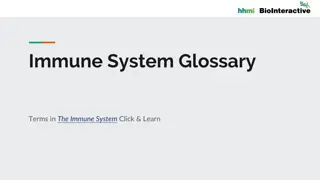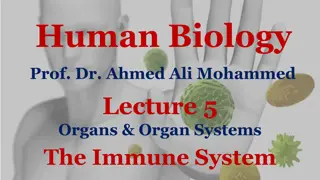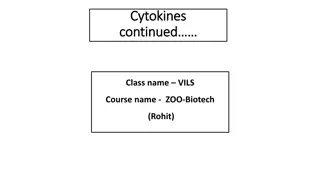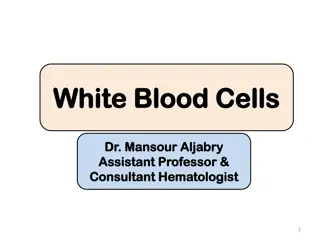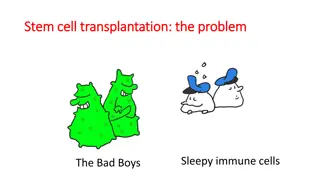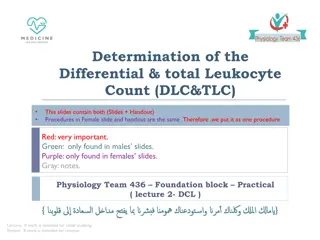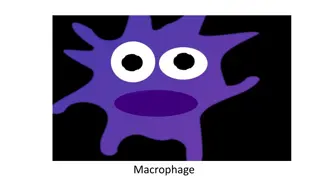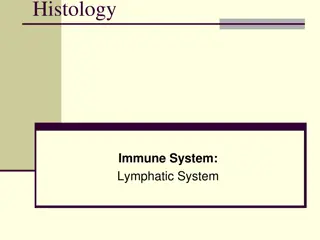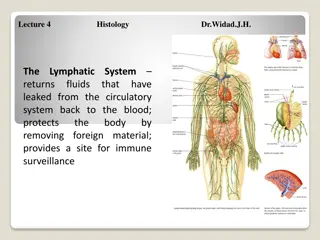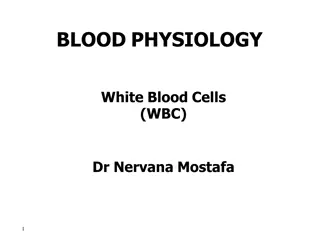Understanding White Blood Cells and the Immune System
Explore the intricate details of white blood cells (WBCs), their types, functions, formation, and crucial role in defending the body against infections. Delve into the immune system, comprising barriers, cells, tissues, and organs that combat invaders, with a focus on innate and adaptive immunity. Learn about major organs involved in immune response and the differentiation of self from non-self. Gain insights into the complement system and how WBCs play a vital role in immune responses.
Download Presentation

Please find below an Image/Link to download the presentation.
The content on the website is provided AS IS for your information and personal use only. It may not be sold, licensed, or shared on other websites without obtaining consent from the author. Download presentation by click this link. If you encounter any issues during the download, it is possible that the publisher has removed the file from their server.
E N D
Presentation Transcript
Females & Males Slides Only Found in Males slides PHYSIOLOGY Only Found in Females slides Vary Important Notes Notes Extra Information
BLOOD PHYSIOLOGY White Blood Cells (WBC)
Objectives At the end of this lecture student should be able to: 1- Describe different Types of WBC 2- Recognize the general functions of WBC 3- Describe genesis and site of formation of WBC. 4- Describe stages of neutrophil formation 5- Describe the role of neutrophils in defending the body against infection 6- Describe the process of phagocytosis 7- Describe Esinophils formation and functions 8- Describe Basophils formation and functions 9- Describe Monocytes and macrophage formation and functions. 10- Describe Reticuloendothelial componants and functions 11- Describe lymphocytes formation and maturation 12- Describe the functions of the different types of lymphocytes. 13- Recognise leucocytosis and leucopenia. 14- Recognize type of leukaemia 15- Outline components of the immune system 16-Describe the structure of the different types of WBCs. 17-Outline differential WBCs count. 18-Describe the role of the WBCs in immune responses and defending against infection. 3
Immune System The immune system is a system of barriers, cells, tissues and organs that work to fight invaders. Another important component of the immune system is the complement system. The major functions of the immune system are: 1. Differentiate self from non-self. 2. Eliminate foreign substances, cells and pathogens. Organization of the immune system Blood Primary (or central) lymphoid organs Secondary (or peripheral) lymphoid organs Cells vasculature and lymph systems connect the different organs
Major organs Primary Lymphoid Organs Secondary (or peripheral) Lymph organs tonsils adenoids spleen Bone marrow Thymus Lymphatic vessels Lymph nodes 1. Immune cells mature to become immunocompetent in these organs. 2. Most cells mature to immune cells within the bone marrow and, after release, begin a life of patrol in the blood. The exception is the pre-T cell, which first undergoes maturation in the thymus before circulating in blood. peyer's patches appendix 1. These are the organs where mature immune cells participate in specific immune defense reactions.
Major organs 2 2 1 2 2 2 2 2 1
Types of Immunity Immune system Innate (non-specific; natural) immunity Adaptive (specific; acquired) immunity 1. Third line of defense. 2. Antigen specificity. It is activated by thousands of diverse antigens. 3. Responds with the proliferation of cells and the generation of antibodies. 4. Responds slowly, being fully activated about 4 days after the immunologic threat. 5. Exhibits immunologic memory, so that repeated exposure to the same infectious agent results in improved resistance against it. 1. Second line of defense 2. Is present at birth 3. Persists throughout life 4. Can be mobilized rapidly and act quickly 5. Attacks all antigens fairly equally
The Complement System is Part of the 1stLine of Defense complement system: 1- The first part of the immune system that meets invaders such as bacteria 2-it is a group of proteins. 3- These proteins flow freely in the blood and can quickly reach the site of an invasion where they can react directly with antigens ( molecules that the body recognizes as foreign substances). functions of complement proteins (When activated ): 1. Trigger inflammation. 2. Attract eater cells such as macrophages to the area. 3. Coat intruders so that eater cells are more likely to devour (swallow and eat) them (a process called as opsonization). 4. Kill intruders.
Cellular Elements of the Innate Immune System (2ndline of defense)
Cells of the Immune System The cells of the immune system work together with different proteins to seek out and destroy anything foreign or dangerous that enters our body. Cells of the Immune System Inflammatory cells Antigen Specific cells Phagocytes Dendritic cells B cells or B lymphocyt es Basophils and Eosinophils Monocytes and macrophages T cells or T lymphocytes Neutrophils Mast cells
White Blood Cells (Leucocytes) Function Protection against infection by: Formation Secretion of antibodies bone marrow lymph tissue Phagocytosis
Remember white blood cells 4000-11000/ml red blood cells (5-6-million/ml) 3
Types of WBC Granular A granular granules (polymorphnuclear PMN) PMNs; because of multiple(lobes) nuclei Neutrophil - 62% - lobulated nucleus basic stain 2-5 - Purple cytoplasmic granules Basophil - 0.4% - rarely segmented nucleus - nucleus hidden by large round bluish granules Monocytes 5.3% kidney shape nucleus (make macrophage system) Eosinophil - 2.3% - 2 lobe nucleus eosin stain - coarse red granules Lymphocyte 30% round nucleus Small large 1-T lymphocyte 2-B lymphocyte 3-Natural killer cells (NKCs) Genesis of WBC: Myelocytic (granular+monocytes) Genesis of WBC: Lymphocytic sites of formation: bone marrow sites of formation: - Bone marrow - Thymus - Lymphoid tiss ( . ) ( )
( Types of WBC . ) 1- Granular (polymorphnuclear PMN): Neutrophil Neutrophil Eosinophil Eosinophil B Basophil asophil 62%. 2.3% 0.4%. 10-16um 12-18um 10-14um lobulated nucleus 2- 5. 2 lobe nucleus. rarely segmented nucleus. coarse red Purplecytoplasmic granules nucleus hidden by large round bluish granules. granules
( . Types of WBC cont. ) 2. A granular Monocytes Monocytes Lymphocyte Lymphocyte 5.3% 30% 15-20um small (5-8um) large (9-15um) kidney shape nucleus round nucleus
Physiological Variations in WBCs Count Age: Infants: about 20,000 /mm3 Children:10,000 to 15,000/mm3 Adults: 4,000 and 11,000/mm3 Sex: males have more WBCs than females. Diurnal variation: Minimum in early morning and maximum in the afternoon. Exercise: Increases slightly. Sleep: Decreases. Emotional conditions like anxiety: Increases. Pregnancy: Increases. Menstruation: Increases. Parturition: Increases. Male Slide
WBCs Concentrations (Normal Counts) and Life Span Percentage of Total WBCs Approximate Normal Range (/ L) Cells 4000 - 11000 Total WBCs 60 70% (62%) 3000 - 6000 Neutrophils 1 4% (2.3%) 150 - 300 Eosinophils 0.4% (0.4%) 0 - 100 Basophils 20 40% (30%) 1500 - 4000 Lymphocytes 2 8% (5.3%) 300 - 600 Monocytes (Macrophages) , .
Life span of WBCs Granulocytes Monocytes Lymphocytes Neutrophil, Eosinophil, Basophil In blood: 10-20 hours Leave to the tissue: - transform into macrophage stay up to months weeks to months according to its type B > few weeks T > year (100-300day) in tissues 4-5 days During Infection: only few hours (they die after ingesting bacteria)
Genesis of WBC (Leucopoiesis) Two major lineage of WBC are formed : Myelocytic: beginning with myelobast and giving rise to granular leucocytes and monocytes Lymphocytic: beginning with lymphoblast and giving rise to lymphocytes the WBC need to leave the blood to work unlike RBC. Sites of WBC Formation Granulocytes (neutrophil, basophil, eosinophil) Monocytes Lymphocytes bone marrow and lymphoid tissues especially the lymph glands, spleen, thymus, tonsils, and Peyer s patches bone marrow in bone marrow
Genesis of WBC WBCs formed in the bone marrow are stored within the marrow until they are needed in the circulatory system. Various factors cause them to be released. Normally, about three times as many white blood cells are stored in the marrow as circulate in the entire blood. The lymphocytes are mostly stored in the various lymphoid tissues, except for a small number that are temporarily being transported in the blood.
Genesis of WBC Leucopoiesis
White Blood Cells NEUTROPHILLS Formation and Maturation of Neutrohils:in Bone Marrow ( Maturation of red blood cells ( ) Stem cells . ) Myeloblast Promyelocytes Neutrophil myelocytes Young neutrophil metamyelocytes Band neutrophil Polymorphnuclear neutrophil (MatureNeutrphils released to blood)
White Blood Cells NEUTROPHILLS Polymorphonuclear. They contain small granules of both acidic and basic. They constitute the first line of defence against bacterial infection. Very important at clearing bacterial infections. Neutrophils Cells infected by bacteria usually get dealt with by
Neutrophil Function Defense against infection: Neutrophil has the ability of engulfing bacteria or organism by a process of phyagocytosis Neutrophil Phagocytosis 1-neutrophil attaches itself to the particle and projects pseudopodia in all directions around the particle. 2-pseudopodia meet one another on the opposite side and fuse, creating an enclosed chamber that contains the phagocytized particle. 3-the chamber moves to the inside of the cytoplasmic cavity and breaks away from the outer cell membrane to form a free-floating phagocytic vesicle (also called a phagosome) inside the cytoplasm. 4-The phagocytized particle is then digested by intracellular enzymes Steps of Phygocytosis Engulfing and killing of a microbe Ameoboid movement Chemotaxis Like alarms Margination Diapedesis Females slide
Chemotaxis The attraction of the neutrophils and monocytes to move to inflamed area following chemotactic substances release from infected site. The chemotactic agents include a component of the complement system (C5a); leukotrienes; and polypeptides from lymphocytes, mast cells, and basophils. Chemotactic substances: - Bacterial toxin - Degenerative products of inflamed tissue Chemotaxis is effective up to 100 micrometers away from an inflamed tissue. Therefore, because almost no tissue area is more than 50 micrometers away from a capillary, the chemo- tactic signal can easily move hordes of WBCs from the capillaries into the inflamed area. - Complement system - Reaction product of plasma clotting
Margination & Diapedesis There are gabs inbetween the endothelial capillaries where the neutrophils squeeze neutrophils through 1- WBCs marginate (aggregate and stick) along the wall of blood capillaries. 2- WBC squeezes itself through endothelial holes leaving blood capillaries (diapedesis) 3- WBCs move by amoeboid motion towards inflammation area following chemotactic substance released from site of infection 4- Upon reaching the site of infection neutrophils start to engulf infecting organism
Phagocytosis and Opsonization Phagocytosis: means cellular ingestion of the offending agent. opsonization is the coating of the invader Selective process: foreign substance recognize by: -Rough surface -No protective protein coat, which prevents phagocytosis. -Marked by certain substance (opsonization) name tag e.g Complement 3 or antibodies making them ready for killing. Neutrophils encircled the bacteria with pseudopodia and engulf it inside into a vacuole (phagosome), takes 3-20 bacteria Opsonization: Complement 3b or antibodies like IgG making them ready for killing a process known as opsonization. Some plasma factors act on the bacteria to make them tasty to the phagocytes (opsonization). The principal opsonins that coat the bacteria are immunoglobulins of a particular class (IgG) and complement proteins.
Microbial killing killing effect results from several powerful oxidizing agents formed by enzymes in the membrane of the phagosome or by a special organelle called the peroxisome. ese oxidizing agents include large quantities of superoxide (O2 ), hydrogen peroxide (H2O2), and hydroxyl ions (OH ), which are lethal to most bacteria, even in small quantities. Digestion of organism inside the phagosome: 1- Fusion of intracellular lysosomes with phagosome vacuole 2- Lysosomes discharge its proteolytic enzymes such as myeloperoxidase, catalase into the vacuole, killing and digesting the engulfed bacteria. And\or Release of bactericidal such as superoxide, hydrogen peroxide to kill the bacteria Some bacteria, notably the tuberculosis bacillus, have coats that are resistant to lysosomal digestion and also secrete substances that partially resist the killing effects of the neutrophils and macrophages.These bacteria are responsible for many of the chronic diseases, an example of which is tuberculosis.
Formation and Maturation of Eosinophils: in Bone Marrow Stem cells ( Maturation of red blood cells ( ) Myeloblast . ) Promyelocytes Eosinophil myelocytes Eosinophil metamyelocytes polymorphnuclear eosinophil (Mature Eosinophil released to blood)
Eosinophil Function 1- they are weak phagocytes. 1- they are weak phagocytes. 2- they are often produced in large numbers in people with parasitic infections, and they migrate in large numbers into tissues diseased by parasites., e.g., ascaris, hook worm, bilharzia. Eosinophils attach themselves to the parasites by way of special surface molecules and release substances that kill many of the parasites ex:(hydrolytic anzymes,superoxide) 3- They are increased in allergic conditions by the release of eosinophil chemotactic factor released from the mast cells and basophiles. 4- Eosinophils phagocytose the antigen-antibody complexes and release substances to neutralize the histamine. ex: (asthma, rhinitis, drug reaction) 4-They may produce profibrinolysin fibrinolysin which digest fibrin clot.
Formation and Maturation of Basophils:in Bone Marrow Stem cells ) ( cells Myeloblast Maturation of red blood ( . ) Promyelocytes Basophil myelocytes Basophil metamyelocyt Polymorphnuclear Basophil (Mature Basophils released to blood) large round cytoplasmic polysaccharide granules which take base dye (methylene blue) and stain blue in color.
Basophils Functions: 1-Both mast cells and basophils secrete: histamine (to prevent clotting), heparin, bradykinin, Serotonin (5HT) (contribute to inflammation response), slow-reacting substance of anaphylaxis (a mixture of three leukotrienes) and a number of lysosomalenzymes. The release of those substances cause local and vascular reactions characteristic of allergic manifestation 2-They are increased in allergic reaction: immediate-type hypersensitivity (allergic) reactions.
Monocytes\ Macrophages Monocytes contain agranular cytoplasm, but when they convert into macrophages and enter tissue, they swell and their cytoplasm become filled with a large number of lysosomes. Monocytes leave the blood stream to tissues and turn into macrophages. Monocytes are young macrophages. Monocytes are big eaters. Monocytes are slower to respond to invaders than neutrophils, but they are larger, have greater capacities, and live longer. 15-20 m - Active cells 60- 80 m
Monocytes\ Macrophages Anti-Inflammatory: - Directly: phagocytosis of bacteria, dead cells. - Indirectly: cooperating with lymphocytes by recognizing foreign body (take in foreign body process it and present it to lymphocytes). Functions of monocytes/macrophages: - First line of defense. - Phagocytosis and killing of microorganisms. They are more Efficient than Neutrophils (100 bacteria vs 3-20 by Neutrphil, larger particles like old RBCs & malarial parasites). - Activation of T cells and initiation of the immune response by presenting the antigen to these cells. - gets rid of waste and survives. Monocytes secrete: - Interleukin-1 (IL-1). - Colony stimulating factor (M-CSF). - Platelet-activating factor (PAF).
Indirect anti-inflammatory Direct anti Inflammatory
Formation and Maturation of Monocytesand Macrophages: in Bone Marrow ( Maturation of red blood cells ( ) Stem cells . ) Monoblast monoblast Promonocyte promonocyte mature monocytes released into blood Stay for 10-20 hours in circulation Then leave blood to tissues transforming into larger cells macrophage Macrophage life span is longer upto few months .
Monocytes\ Macrophages There are two types of macrophages; motile and fixed. There are tissue-specific macrophages; fixed macrophages (monocyte-macrophage system; reticulo-endothelial system) - Alveolar macrophage - Peritoneal macrophage - Kuppfer cells in liver sinuses - Osteoclasts in bone - Microglial cells in brain - Histiocytes in skin and subcutaneous tissue - Mesengial cells in the kidneys - Few specialized endothelial cells in lymph nodes bone marrow, spleen and
Reticuloendothelial System Consist of: Monocytes Macrophage Endothelial cells (bone marrow,spleen, lymph node) Located in: all tissues especially: skin (histocytes), liver (kupffer), spleen, bone marrow, lymph nodes, lung ( . )
Functions of Reticuloendothelialsystem -Phagocytosis: Bacterial, dead cells, foreign particles. -Breakdown of Hb -Immune function: processing antigen and antibodies production (indirect) -Storage of iron in the liver and bone marrow in the form of fe3 (mostly),fe2
Macrophage and Neutrophil Responses During Inflammation Neutrophils = microphages 1st line of defense Tissue macrophages, barriers and complement system. 2nd line of defense Neutrophil invasion of the inflamed area. 3rdline of defense Monocytes macrophage invasion of inflamed area. 4thline of defense Increased production of granulocytes and monocytes by the bone marrow.
LYMPHOCYTES Function and types Types: 1-Thymus dependent (T-lymphocytes) 2 -Thymus independent (B-lymphocytes) LYMPHOCYTES ARE RESPONSIBLE FOR ADAPTED/ACQUIRED IMMUNITY Function:
LymphocytesFormation and Maturation: T lymphocyte and B lymphocyte produced by the bone marrow however, T get maturated in the thymus and the B cells in the bone marrow then they go to the lymphoid organs like spleen Lymph nodes etc Formed in bone marrow, thymus, lymphoid tissues Stem cells (thymus, lymphoid tissue & bone marrow) ( Maturation of red blood cells ( ) . ) lymphoblast intermediate pyronophilic blast cell lymphocytes Life Span Of Lymphocytes range from weeks to months according to its type. Both types of lymphocytes are derived in the embryo from (pluripotent hematopoietic stem cells) that form common (lymphoid progenitor cells).








